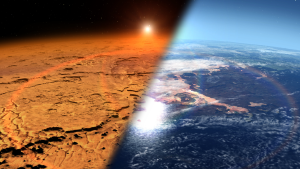Blog
Lights on Mars
17 December 2019
 NASA’s Goddard Space Flight Center
NASA’s Goddard Space Flight CenterIn the TV series The Expanse, there is a short scene where one character comments to the other about the oddness of seeing northern lights on Mars. Northern lights, or more generally aurora, are common on Earth because of its thick, water-rich atmosphere and strong magnetic field. Present-day Mars is a dry world with a weak magnetic field. It would take a bit of terraforming to see northern lights on the red planet.
In its youth, Mars was a wet world with a thick atmosphere. It could have had visible aurora in the past. Today Mars has no visible aurora, but it does have ultraviolet aurora. These are known as proton aurora, and they occur with the solar wind strikes hydrogen atoms in the upper atmosphere of Mars. While these aurora are invisible to the naked eye, they tell the story of how Mars became a dry world.
The proton aurora was first detected by the MAVEN spacecraft in 2015, and so it has had a chance to study the aurora for several years. Recently it was found that the aurora is strongest during the summer season of Mars’ southern hemisphere. This corresponds to the period when the planet as a whole is its warmest. The MAVEN team found that this is also the time when the most water vapor is pushed into the upper atmosphere, where ultraviolet light breaks it apart into hydrogen and oxygen.
So the aurora of Mars are seasonal, and driven by warmed water vapor. It shows how water is pushed to the upper atmosphere, and once there the weak gravity of Mars can’t hold onto it well. Over time, water escaped Mars, and the planet became increasingly dry. This is part of the reason Earth and Mars are so different today, even though they were once very similar.
Perhaps in the far future Mars will again be transformed into a wet, habitable world. If it does there could be northern lights on Mars once again. But for now, only faint ultraviolet aurora remain as a tale of what once was.